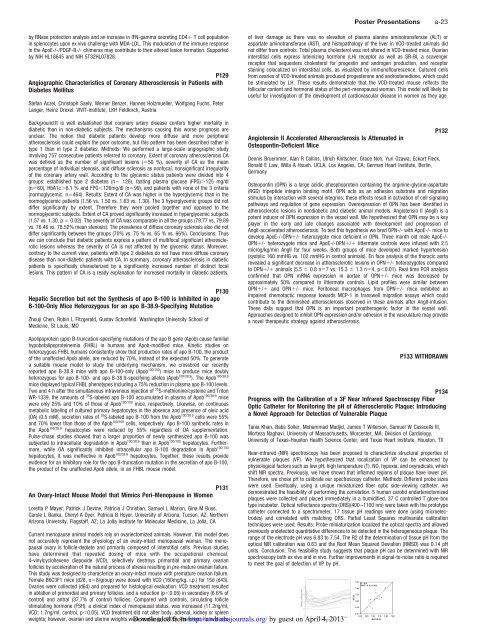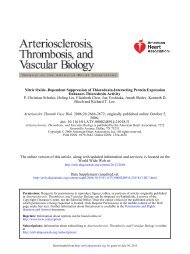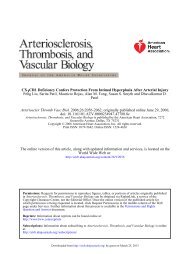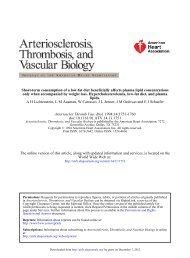Oral Presentations - Arteriosclerosis, Thrombosis, and Vascular ...
Oral Presentations - Arteriosclerosis, Thrombosis, and Vascular ...
Oral Presentations - Arteriosclerosis, Thrombosis, and Vascular ...
You also want an ePaper? Increase the reach of your titles
YUMPU automatically turns print PDFs into web optimized ePapers that Google loves.
y RNase protection analysis <strong>and</strong> an increase in IFN-gamma secreting CD4 T cell population<br />
in splenocytes upon ex vivo challenge with MDA-LDL. This modulation of the immune response<br />
in the ApoE-/-/PDGF-B-/- chimeras may contribute to their altered lesion formation. Supported<br />
by NIH HL18645 <strong>and</strong> NIH 5T32HL07828.<br />
P129<br />
Angiographic Characteristics of Coronary Atherosclerosis in Patients with<br />
Diabetes Mellitus<br />
Stefan Aczel, Christoph Saely, Werner Benzer, Hannes Holzmueller, Wolfgang Fuchs, Peter<br />
Langer, Heinz Drexel. VIVIT-Institute, LKH Feldkirch, Austria<br />
Background:It is well established that coronary artery disease confers higher mortality in<br />
diabetic than in non-diabetic subjects. The mechanisms causing this worse prognosis are<br />
unclear. The notion that diabetic patients develop more diffuse <strong>and</strong> more peripheral<br />
atherosclerosis could explain the poor outcome, but this pattern has been described rather in<br />
type 1 than in type 2 diabetes. Methods: We performed a large-scale angiographic study<br />
involving 757 consecutive patients referred to coronary. Extent of coronary atherosclerosis CA<br />
was defined as the number of significant lesions (50 %), severity of CA as the mean<br />
percentage of individual stenosis, <strong>and</strong> diffuse sclerosis as nonfocal, nonsignificant irregularity<br />
of the coronary artery wall. According to the glycemic status patients were divided into 4<br />
groups: established type 2 diabetes (n 128), fasting plasma glucose (FPG)125 mg/dl<br />
(n60), HbA1c6.1 % <strong>and</strong> FPG126mg/dl (n99), <strong>and</strong> patients with none of the 3 criteria<br />
(normoglycemic, n464). Results: Extent of CA was higher in the hyperglycemic than in the<br />
normoglycemic patients (1.56 vs. 1.50 vs. 1.63 vs. 1.30). The 3 hyperglycemic groups did not<br />
differ significantly by extent. Therefore they were pooled together <strong>and</strong> opposed to the<br />
normoglycemic subjects. Extent of CA proved significantly increased in hyperglycemic subjects<br />
(1.57 vs. 1.30, p 0.02). The severity of CA was comparable in all the groups (79.77 vs. 79.89<br />
vs. 76.46 vs. 78.52% mean stenosis). The prevalence of diffuse coronary sclerosis also did not<br />
differ significantly between the groups (70% vs. 75 % vs. 65 % vs. 66%). Conclusions: Thus<br />
we can conclude that diabetic patients express a pattern of multifocal significant atherosclerotic<br />
lesions whereas the severity of CA is not affected by the glycemic status. Moreover,<br />
contrary to the current view, patients with type 2 diabetes do not have more diffuse coronary<br />
disease than non-diabetic patients with CA. In summary, coronary atherosclerosis in diabetic<br />
patients is specifically characterized by a significantly increased number of distinct focal<br />
lesions. This pattern of CA is a ready explanation for increased mortality in diabetic patients.<br />
P130<br />
Hepatic Secretion but not the Synthesis of apo B-100 is Inhibited in apo<br />
B-100-Only Mice Heterozygous for an apo B-38.9-Specifying Mutation<br />
Zhouji Chen, Robin L Fitzgerald, Gustav Schonfeld. Washington University School of<br />
Medicine, St Louis, MO<br />
Apolipoprotein (apo) B-truncation-specifying mutations of the apo B gene (Apob) cause familial<br />
hypobetalipoproteinemia (FHBL) in humans <strong>and</strong> Apob-modified mice. Kinetic studies on<br />
heterozygous FHBL humans consistently show that production rates of apo B-100, the product<br />
of the unaffected Apob allele, are reduced by 70%, instead of the expected 50%. To generate<br />
a suitable mouse model to study the underlying mechanism, we crossbred our recently<br />
reported apo B-38.9 mice with apo B-100-only (Apob 100/100 ) mice to produce mice doubly<br />
heterozygous for apo B-100- <strong>and</strong> apo B-38.9-specifying alleles (Apob 100/38.9 ). The Apob 100/38.9<br />
mice displayed typical FHBL phenotypes including a 75% reduction in plasma apo B-100 levels.<br />
Two <strong>and</strong> 4 h after the simultaneous intravenous injection of 35 S-methionine/cysteine <strong>and</strong> Triton<br />
WR-1339, the amounts of 35 S-labeled apo B-100 accumulated in plasma of Apob 100/38.9 mice<br />
were only 25% <strong>and</strong> 10% of those of Apob 100/100 mice, respectively. Likewise, on continuous<br />
metabolic labeling of cultured primary hepatocytes in the absence <strong>and</strong> presence of oleic acid<br />
(OA) (0.5 mM), secretion rates of 35 S-labeled apo B-100 from the Apob 100/38.9 cells were 55%<br />
<strong>and</strong> 70% lower than those of the Apob 100/100 cells, respectively. Apo B-100 synthetic rates in<br />
the Apob 100/38.9 hepatocytes were reduced by 55% regardless of OA supplementation.<br />
Pulse-chase studies showed that a larger proportion of newly synthesized apo B-100 was<br />
subjected to intracellular degradation in Apob 100/38.9 than in Apob 100/100 hepatocytes. Furthermore,<br />
while OA significantly inhibited intracellular apo B-100 degradation in Apob 100/100<br />
hepatocytes, it was ineffective in Apob 100/38.9 hepatocytes. Together, these results provide<br />
evidence for an inhibitory role for the apo B-truncation mutation in the secretion of apo B-100,<br />
the product of the unaffected Apob allele, in an FHBL mouse model.<br />
P131<br />
An Ovary-Intact Mouse Model that Mimics Peri-Menopause in Women<br />
Loretta P Mayer, Patrick J Devine, Patricia J Christian, Samuel L Marion, Gina M Buss,<br />
Carole L Banka, Cheryl A Dyer, Patricia B Hoyer. University of Arizona, Tucson, AZ; Northern<br />
Arizona University, Flagstaff, AZ; La Jolla Institute for Molecular Medicine, La Jolla, CA<br />
Current menopause animal models rely on ovariectomized animals. However, this model does<br />
not accurately represent the physiology of an ovary-intact menopausal woman. The menopausal<br />
ovary is follicle-deplete <strong>and</strong> primarily composed of interstitial cells. Previous studies<br />
have determined that repeated dosing of mice with the occupational chemical,<br />
4-vinylcyclohexene diepoxide (VCD), selectively destroys primordial <strong>and</strong> primary ovarian<br />
follicles by acceleration of the natural process of atresia resulting in pre-mature ovarian failure.<br />
This study was designed to characterize an ovary-intact mouse with premature ovarian failure.<br />
Female B6C3F1 mice (d28, n8/group) were dosed with VCD (160mg/kg, i.p.) for 15d (d43).<br />
Ovaries were collected (d64) <strong>and</strong> prepared for histological evaluation. VCD treatment resulted<br />
in ablation of primordial <strong>and</strong> primary follicles, <strong>and</strong> a reduction (p0.05) in secondary (6.6% of<br />
control) <strong>and</strong> antral (37.7% of control) follicles. Compared with controls, circulating follicle<br />
stimulating hormone (FSH), a clinical index of menopausal status, was increased (11.2ng/ml,<br />
VCD; 1.7ng/ml, control, p0.05). VCD treatment did not alter body, adrenal, kidney or spleen<br />
weights; however, ovarian <strong>and</strong> uterine weights were Downloaded smaller (p0.05). from<br />
There was no evidence<br />
Poster <strong>Presentations</strong> a-23<br />
of liver damage as there was no elevation of plasma alanine aminotransferase (ALT) or<br />
aspartate aminotransferase (AST), <strong>and</strong> histopathology of the liver in VCD-treated animals did<br />
not differ from controls. Total plasma cholesterol was not altered in VCD-treated mice. Ovarian<br />
interstitial cells express luteinizing hormone (LH) receptor as well as SR-BI, a scavenger<br />
receptor that sequesters cholesterol for progestin <strong>and</strong> <strong>and</strong>rogen production, <strong>and</strong> receptor<br />
staining colocalized on interstitial cells, as visualized by immunoflourescence. Cultured cells<br />
from ovaries of VCD-treated animals produced progesterone <strong>and</strong> <strong>and</strong>rostenedione, which could<br />
be stimulated by LH. These results demonstrate that the VCD-treated mouse reflects the<br />
follicular content <strong>and</strong> hormonal status of the peri-menopausal woman. This model will likely be<br />
useful for investigation of the development of cardiovascular disease in women as they age.<br />
Angiotensin II Accelerated Atherosclerosis Is Attenuated in<br />
Osteopontin-Deficient Mice<br />
Dennis Bruemmer, Alan R Collins, Ulrich Kintscher, Grace Noh, Yuri Ozawa, Eckart Fleck,<br />
Ronald E Law, Willa A Hsueh. UCLA, Los Angeles, CA; German Heart Institute, Berlin,<br />
Germany<br />
P132<br />
Osteopontin (OPN) is a large acidic phosphoprotein containing the arginine-glycine-aspartate<br />
(RGD) tripeptide integrin binding motif. OPN acts as an adhesion substrate <strong>and</strong> migration<br />
stimulus by interaction with several integrins; these effects result in activation of cell signaling<br />
pathways <strong>and</strong> regulation of gene expression. Overexpression of OPN has been identified in<br />
atherosclerotic lesions in nondiabetic <strong>and</strong> diabetic animal models. Angiotensin II (AngII) is a<br />
potent inducer of OPN expression in the vessel wall. We hypothesized that OPN may be a key<br />
player in the early <strong>and</strong> late changes associated with development <strong>and</strong> progression of<br />
AngII-accelerated atherosclerosis. To test this hypothesis we bred OPN-/- with ApoE-/- mice to<br />
develop ApoE-/-OPN/- heterozygote mice deficient in OPN. Three month old male ApoE-/-<br />
OPN/- heterozygote mice <strong>and</strong> ApoE-/-OPN/ littermate controls were infused with 2.5<br />
microg/kg/min AngII for four weeks. Both groups of mice developed marked hypertension<br />
(systolic 160 mmHG vs. 102 mmHG in control animals). En face analysis of the thoracic aorta<br />
revealed a significant decrease in atherosclerotic lesions in OPN/- heterozygotes compared<br />
to OPN/ animals (5.5 0.8 n7 vs. 15.3 1.3 n4, p0.01). Real time PCR analysis<br />
confirmed that OPN mRNA expression in aortae of OPN/- mice was decreased by<br />
approximately 50% compared to littermate controls. Lipid profiles were similar between<br />
OPN/ <strong>and</strong> OPN/- mice. Peritoneal macrophages from OPN/- mice exhibited an<br />
impaired chemotactic response towards MCP-1 in transwell migration assays which could<br />
contribute to the diminished atherosclerosis observed in these animals after AngII-infusion.<br />
These data suggest that OPN is an important proatherogenic factor in the vessel wall.<br />
Approaches designed to inhibit OPN expression <strong>and</strong>/or adhesion in the vasculature may provide<br />
a novel therapeutic strategy against atherosclerosis.<br />
P133 WITHDRAWN<br />
P134<br />
Progress with the Calibration of a 3F Near Infrared Spectroscopy Fiber<br />
Optic Catheter for Monitoring the pH of Atherosclerotic Plaque: Introducing<br />
a Novel Approach for Detection of Vulnerable Plaque<br />
Tania Khan, Babs Soller, Mohammad Madjid, James T Willerson, Samuel W Casscells III,<br />
Morteza Naghavi. University of Massachusetts, Worcester, MA; Division of Cardiology,<br />
University of Texas-Houston Health Science Center, <strong>and</strong> Texas Heart Institute, Houston, TX<br />
Near-infrared (NIR) spectroscopy has been proposed to characterize structural properties of<br />
vulnerable plaques (VP). We hypothesized that localization of VP can be enhanced by<br />
physiological factors such as low pH, high temperature (T), NO, hypoxia, <strong>and</strong> oxyradicals, which<br />
shift NIR spectra. Previously, we have shown that inflamed regions of plaque have lower pH.<br />
Therefore, we chose pH to calibrate our spectroscopy catheter. Methods: Different probe sizes<br />
were used. Eventually, using a unique miniaturized fiber optic side-viewing catheter, we<br />
demonstrated the feasibility of performing the correlation. 5 human carotid endarterectomized<br />
plaques were collected <strong>and</strong> placed immediately in a humidified, 37 C controlled T glove-box<br />
type incubator. Optical reflectance spectra (ORS)(400 –1100 nm) were taken with the prototype<br />
catheter connected to a spectrometer. 17 tissue pH readings were done (using microelectrodes)<br />
<strong>and</strong> correlated with matching ORS. Partial Least Squares multivariate calibration<br />
techniques were used. Results: Probe miniaturization localized the optical spectra <strong>and</strong> allowed<br />
previously undetected quantitative differences to be detected in the heterogeneous plaque. The<br />
range of the electrode pH was 6.83 to 7.54. The R2 of the determination of tissue pH from the<br />
optical NIR calibration was 0.63 <strong>and</strong> the Root Mean Squared Deviation (RMSD) was 0.14 pH<br />
units. Conclusion: This feasibility study suggests that plaque pH can be determined with NIR<br />
spectroscopy both ex vivo <strong>and</strong> in vivo. Further improvements in signal-to-noise ratio is required<br />
to meet the goal of detection of VP by pH.<br />
http://atvb.ahajournals.org/ by guest on April 4, 2013














